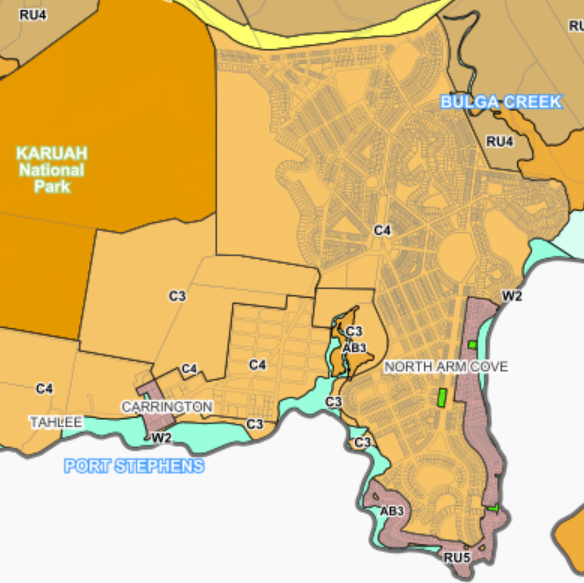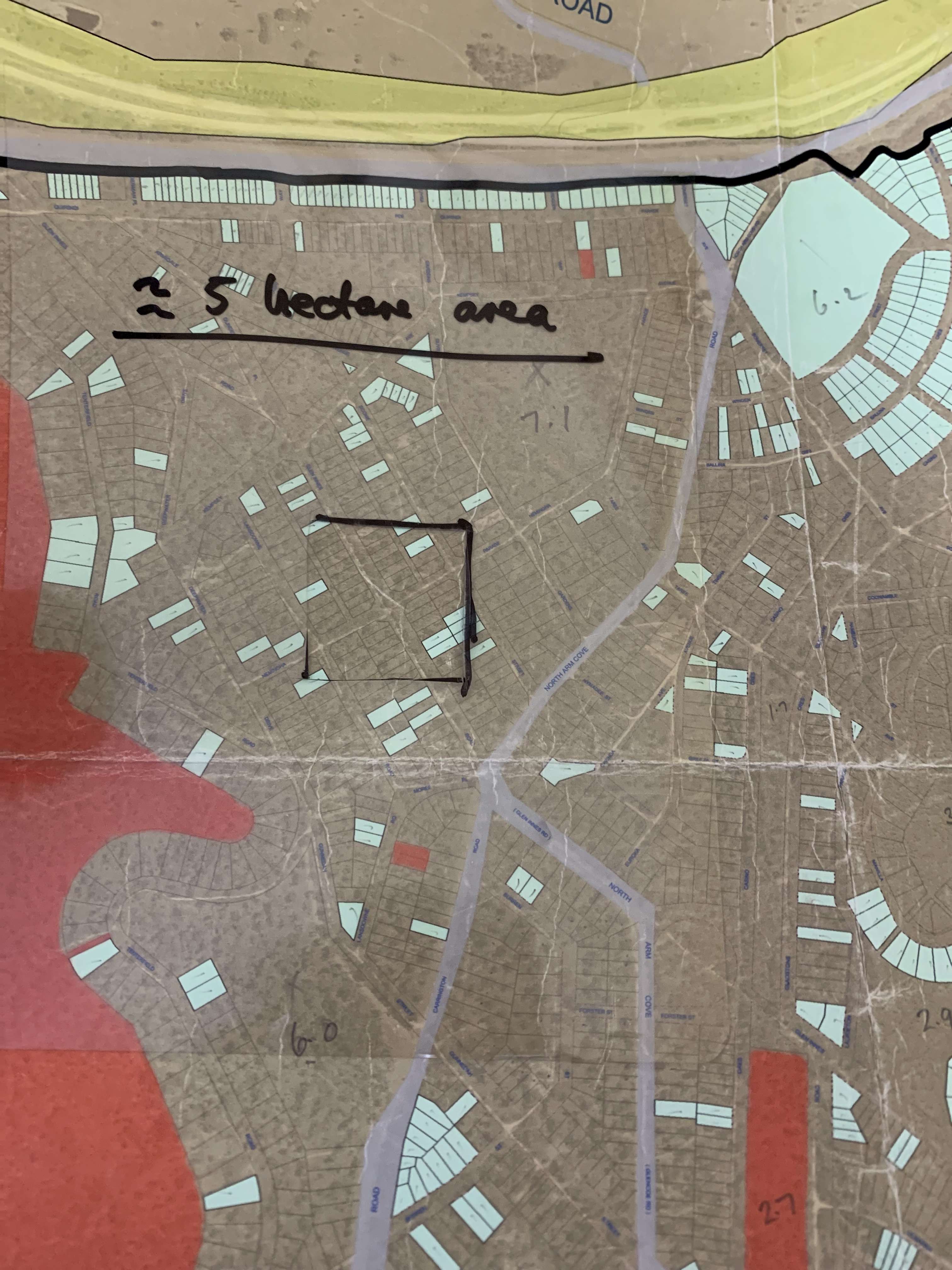This article shows that consolidating lots to form 5 hectare blocks in the North Arm Cove (NAC) paper subdivision is financially unviable, the potential number of five hectare blocks that could be formed is very low, and Walker Corporation will be the main beneficiary from the rezoning and owners of small residential sized lots will get no benefit from it.
In its Paper Subdivision Analysis report, MidCoast Council found that the North Arm Cove and Carrington paper subdivisions were not suitable for development, and the land should be rezoned as C2 Environmental Conservation, or C3 Environmental Management with a minimum lot size for a dwelling of 20 hectares.
The State Government has overridden this analysis with its Gateway Determination, and required MidCoast paper subdivisions to be rezoned as C4 Environmental Living with a minimum lot size for a dwelling entitlement of 5 hectares in the draft LEP. The Government stated that this was to “balance the ability of landowners to have a fair and reasonable pathway to lodge a development application of a dwelling with the need to manage essential services, natural hazards and biodiversity values”.

After the publication of the draft LEP, I decided to have a look at the North Arm Cove and Carrington paper subdivisions to work out firstly if it would be financially viable to consolidate smaller blocks to achieve 5 hectare blocks, and secondly how many 5 hectare blocks could potentially be established in these paper subdivisions.
The results from my workings were quite interesting.
Firstly, based on current average selling prices for North Arm Cove paper subdivision lots, the estimated cost for a person to consolidate the 50 lots needed to form one five hectare environmental living block would be about $2.1m. Since such a block would be worth about $600,000, whoever consolidated these 50 blocks would be pouring about $1.5m down the proverbial drain!
Secondly, considering the constraints from public and private roads, and Council owned lots, only about 31 five hectare blocks could potentially be formed in the North Arm Cove and Carrington paper subdivisions.
The main beneficiary of this would be Walker Corporation, the largest landowner in the paper subdivisions, which could potentially establish 26 five hectare blocks on its land.
The other potential 5 five hectare blocks could be established on privately owned lots that are from 3.3 – 4.8 hectares in area.
Due to constraints from roads and Council owned lots, the vast majority of the 2,500 owners of small lots will get no benefit at all from the proposed rezoning. They will not be able to consolidate 50 lots to form one Environmental Living five hectare block.
The State Governments “fair and reasonable pathway to lodge a development application of a dwelling” doesn’t exist for the vast majority of landowners in the North Arm Cove and Carrington paper subdivisions.
Unfortunately, on the surface the proposal for the Environmental Living zoning looks as though it will provide hope for the 2,500 small lot owners, but when it is analysed in detail in reality it gives false hope, it provides no benefit at all except for maybe five owners only.
It appears to me that the Government didn’t do its homework properly, and came up with this “fair and reasonable pathway” without doing any analysis of its viability.
The following two sections explain my analysis. I encourage readers to review my workings and challenge my results. Maybe I made some mistakes. I hope for the sake of the 2,500 owners of small lots that I am wrong, but I don’t think that I am.
1.Would it be financially viable to consolidate smaller lots in the North Arm Cove paper subdivision to form 5 hectare blocks that have a dwelling entitlement?
Using an lot average size of 1,000 square metres, to form one five hectare block a person would need a total of 50 lots.
The average selling price for paper subdivision lots sold in the period from 1 January 2024 to 2 April 2024 was $39,466 each (15 lots sold with an average area of 959 square metres each). Thus if a person already owned one lot the cost for them to purchase an additional 49 lots would be $1,933,834 plus the cost of stamp duty and conveyancing/legal fees (say $2,000 per property), giving a total cost of $2,031,834 for one five hectare block.
In addition to the purchase cost of these lots, there would be legal fees to consolidate them into one five hectare block, plus the cost of formed road access, power and communications that would be needed for a dwelling. Say a total of about $2.1m to form one five hectare block.
So for a total of about $2.1m, an existing owner of one 1,000 square metre lot in the paper subdivision, could form one five hectare block which would have no reticulated water or sewer, but with an entitlement, subject to council approval, for one dwelling to be constructed on the block.
For comparison, today, for $2.1m one could purchase a 52 hectare farm with a large luxury house at Pindimar, for $1.35m one could purchase a waterfront home in the North Arm Cove village, or for $525,000 one could purchase a 4 hectare rural property with a large shed at Limeburners Creek.
Using the Limeburners Creek property as an example, a 5 hectare unserviced block in the paper subdivision would be worth no more than about $600,000.
Based on this simple analysis, consolidating 50 lots in the North Arm Cove paper subdivision to form one unserviced 5 hectare block would be financially disasterous, and a person that did it would be wasting about $1.5m ($2.1m minus $600,000) - an awful lot of money wasted that would be better off spent elsewhere.
2.How many 5 hectare blocks could potentially be established in the NAC and Carrington paper subdivisions?
To do this analysis I looked at the NAC and Carrington paper subdivisions separately.
North Arm Cove Paper subdivision
This paper subdivision contains some 3,500 lots over 730 hectares, with about 1,000 of these lots being owned by Council, and about 2,500 being owned privately. Now looking at the large, medium and small lots separately:
Large lots (over 20 hectares)
Walker Corporation – owns one large lot of 91.8 hectares. Potentially 18 five hectare blocks could be established on this lot.
Alathan – owns one lot of 67 hectares containing the private owned roads on the northern side of Carrington Rd. Due to the configuration of this lot and considering that owners of properties adjacent to these private roads have a legal right of way over this land for access, it is highly unlikely that it could be subdivided into 5 hectare blocks. Thus no 5 hectare blocks could be established on this lot.
Medium lots (5 – 20 hectares)
Walker Corporation – owns five lots of 14.3, 10.1, 7.8 and 5.5 hectares area. Potentially 6 five hectare blocks plus one more with some consolidation of some adjacent lots. One lot of 4.6 hectares that could be added to by consolidation to form one five hectare block. Total potentially 8 blocks could be established.
Privately owned lots – two lots of 7.1 and 6.0 hectares area. Potentially 2 five hectare blocks.
There are also three lots of 4.8, 4.2 and 3.3 hectares that could be added to by consolidation. Total potentially 5 five hectare blocks.
Small lots
Working out the potential for consolidating some 2,500 small lots into 5 hectare blocks seemed quite daunting at first. With the large and medium lots this was easy to do using the interactive draft zoning map on Councils website.
In the end it wasn’t difficult at all. I have a very large printed map of NAC showing lots, roads, Walker Corporation land, and Council owned land, so I made up a clear plastic overlay with a 5 hectare square hole in it at the same scale as the map.
By placing this overlay on the map I could easily see what was needed to form a five hectare lot. The photo below shows this in action. I have also attached a copy of the map that I used for this analysis.

By moving this overlay all over the map I could see that there were many constraints that prevented consolidation – Council or privately owned roads, road reserves and dunny lanes: and Council owned lots (which are the light green coloured lots in the photo. Walker Corp land is red shaded).
Since Council has stated that it is not going to sell any of the lots that it owns and has stated it will keep them for conservation in perpetuity, they cannot be used to form consolidated 5 hectare blocks. And it wouldn’t be feasible for Council to sell off sections of its roads or road reserves since they are needed for access to lots adjoining them.
As a result of these constraints, I could not find any area of small lots without constraints that could be consolidated to form five hectare lots. So the potential for consolidating small lots into five hectare lots is effectively zero.
Carrington paper subdivision
The Carrington paper subdivision contains 65 lots over 90 hectares. Most of it is owned by Walker Corporation.
There is only one lot of 5.0 hectares. It could potentially form 1 five hectare block.
The remainder are small lots with over 20 lots of 2 hectares size. These all have constraints of Council owned roads or road reserves, with virtually no potential for consolidation.
The overall result
Walker Corporation get a huge benefit from the draft LEP. They could potentially get 26 five hectare blocks by subdividing or consolidating existing lots.
Private landowners have the potential for 2-5 five hectare blocks.
So all up, the potential for 5 hectare blocks in the North Arm Cove and Carrington paper subdivisions is a total of 31 blocks.
All of the remaining 2,500 private landowners will receive no benefit at all.


